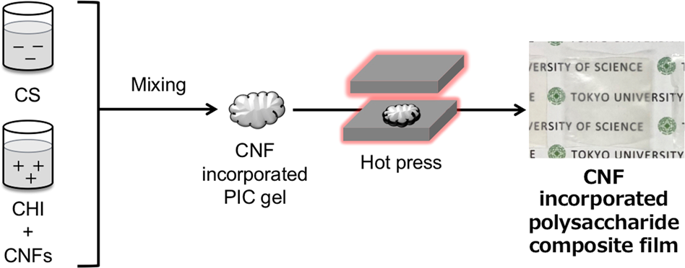Our official English website, www.x-mol.net, welcomes your feedback! (Note: you will need to create a separate account there.)
Enhancement of the mechanical properties of polysaccharide composite films utilizing cellulose nanofibers
Polymer Journal ( IF 2.8 ) Pub Date : 2020-02-05 , DOI: 10.1038/s41428-020-0311-3 Yusuke Yataka , Ayami Suzuki , Kazutoshi Iijima , Mineo Hashizume
Polymer Journal ( IF 2.8 ) Pub Date : 2020-02-05 , DOI: 10.1038/s41428-020-0311-3 Yusuke Yataka , Ayami Suzuki , Kazutoshi Iijima , Mineo Hashizume

|
We have demonstrated that free-standing films with thicknesses of several tens of micrometers made from chondroitin sulfate C (CS) and chitosan (CHI) are readily obtained by utilizing the hot press technique. To improve the mechanical properties of the polysaccharide composite films, especially in the wet state, we investigated the incorporation of cellulose nanofibers (CNFs) in the films as a nanofiller in the present study. CNFs were homogeneously incorporated into polyion complex (PIC) gels under optimized conditions. The CNF-incorporated films were evaluated morphologically and spectroscopically by optical and electron microscopy and infrared microscopy; the results indicated that there were micrometer-scale domains in the CNF-incorporated films. The mechanical properties of the CNF-incorporated films were also investigated in the dried and wet states. Especially in the wet state, the Young’s moduli were effectively enhanced with an increased weight fraction of CNFs in the films. The mechanism of the filler effects was determined in terms of the dependency of the CNF content on the mechanical properties of the films. The results indicated that the nonionic nanofillers were incorporated with minimum influences on polysaccharide PIC formation, which contributed to the effective enhancement of film strength. Cellulose nanofibers (CNFs) were utilized as nanofillers to improve mechanical properties of polysaccharide composite films made of polyion complexes (PICs) of chondroitin sulfate C (CS) and chitosan (CHI). Nonionic CNFs were homogeneously incorporated in the PIC gels, constructed by multiple electrostatic interactions, and the resulting free-standing films. The filler effects of CNFs were observed, especially in the Young’s modulus of the films in the wet state. Results indicated that CNFs in the films formed a rigid network structure with polysaccharides, contributing the reinforcement of the film strength.
中文翻译:

利用纤维素纳米纤维增强多糖复合膜的机械性能
我们已经证明,使用热压技术很容易获得由硫酸软骨素 C (CS) 和壳聚糖 (CHI) 制成的厚度为几十微米的独立薄膜。为了提高多糖复合膜的机械性能,特别是在湿状态下,我们研究了在本研究中将纤维素纳米纤维 (CNF) 作为纳米填料掺入薄膜中。在优化条件下,CNFs 被均匀地掺入聚离子复合物 (PIC) 凝胶中。通过光学和电子显微镜以及红外显微镜对掺入 CNF 的薄膜进行形态学和光谱学评估;结果表明,在掺入 CNF 的薄膜中存在微米级区域。还研究了在干燥和潮湿状态下掺入 CNF 的薄膜的机械性能。特别是在湿润状态下,随着薄膜中 CNF 重量分数的增加,杨氏模量得到有效增强。填料效应的机制是根据 CNF 含量对薄膜机械性能的依赖性来确定的。结果表明,非离子纳米填料的加入对多糖PIC形成的影响最小,有助于有效提高薄膜强度。纤维素纳米纤维 (CNFs) 被用作纳米填料,以改善由硫酸软骨素 C (CS) 和壳聚糖 (CHI) 的聚离子复合物 (PICs) 制成的多糖复合膜的机械性能。非离子 CNF 均匀地掺入 PIC 凝胶中,由多重静电相互作用构成,以及由此产生的独立薄膜。观察到 CNF 的填料效应,特别是在湿态薄膜的杨氏模量中。结果表明,薄膜中的CNFs与多糖形成刚性网络结构,有助于增强薄膜强度。
更新日期:2020-02-05
中文翻译:

利用纤维素纳米纤维增强多糖复合膜的机械性能
我们已经证明,使用热压技术很容易获得由硫酸软骨素 C (CS) 和壳聚糖 (CHI) 制成的厚度为几十微米的独立薄膜。为了提高多糖复合膜的机械性能,特别是在湿状态下,我们研究了在本研究中将纤维素纳米纤维 (CNF) 作为纳米填料掺入薄膜中。在优化条件下,CNFs 被均匀地掺入聚离子复合物 (PIC) 凝胶中。通过光学和电子显微镜以及红外显微镜对掺入 CNF 的薄膜进行形态学和光谱学评估;结果表明,在掺入 CNF 的薄膜中存在微米级区域。还研究了在干燥和潮湿状态下掺入 CNF 的薄膜的机械性能。特别是在湿润状态下,随着薄膜中 CNF 重量分数的增加,杨氏模量得到有效增强。填料效应的机制是根据 CNF 含量对薄膜机械性能的依赖性来确定的。结果表明,非离子纳米填料的加入对多糖PIC形成的影响最小,有助于有效提高薄膜强度。纤维素纳米纤维 (CNFs) 被用作纳米填料,以改善由硫酸软骨素 C (CS) 和壳聚糖 (CHI) 的聚离子复合物 (PICs) 制成的多糖复合膜的机械性能。非离子 CNF 均匀地掺入 PIC 凝胶中,由多重静电相互作用构成,以及由此产生的独立薄膜。观察到 CNF 的填料效应,特别是在湿态薄膜的杨氏模量中。结果表明,薄膜中的CNFs与多糖形成刚性网络结构,有助于增强薄膜强度。


























 京公网安备 11010802027423号
京公网安备 11010802027423号